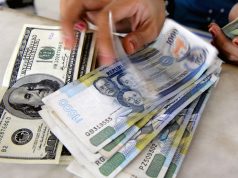Peso expected to start the year on a strong note on remittances
THE PESO is seen to start the new year stronger against the dollar as it is boosted by the continued influx of remittances.
On Friday, the trading day of 2017, the local currency closed at P49.93 against the greenback, gaining five centavos from its P49.98-to-a-dollar finish the previous session.
The last trading week of 2017 saw the local unit rally as it returned to the P49 level for the first time in over six months.
The peso’s ascent was attributable to the reduction of long dollar positions, continuous remittance flows, and some concerns over the US tax revamp.
Traders interviewed over the weekend said the peso will likely sustain its rally against the greenback this week as overseas Filipinos continue to send home money even after the holidays.
“We’re still expecting a surge of remittance inflows, so this will continue to drive the peso,” a trader said over the phone, noting that there would be a backlog following the two-day holiday break.
Aside from this, Ruben Carlo O. Asuncion, chief economist of UnionBank of the Philippines, said the peso will be boosted by upbeat views on the country’s economic growth.
“[Another driver] will be the lingering optimism on Philippine economic growth, both for [fourth quarter] and 2017 as a whole,” Mr. Asuncion said in a text message.
In mid-December, the World Bank hiked its 2017 growth forecast for the Philippines to 6.7% from 6.6% previously on the back of the stronger-than-expected gross domestic product (GDP) growth rate for the third quarter, as well as the upward revision of the second-quarter print.
Asian Development Bank also raised its economic growth projection in the Philippines for 2017 to 6.7% from 6.5%, citing robust growth and accelerated infrastructure spending.
However, Mr. Asuncion noted that: “[I]nvestors would be cautious based on expected future monetary policy tweaks.”
Market players in the US are looking at the Federal Reserve to hike their rates four or more times this year, more than their forecast of three rate hikes, as they might be compelled to normalize their policies quicker following the Republican tax overhaul.
Meanwhile, Asian currencies firmed on Tuesday, marking a strong start for the new year as sentiment was boosted by gains in the euro, while a weaker US dollar prompted further interest in Asia.
The Taiwan dollar was the biggest percentage gainer, rising 0.8% against the dollar to a more than four-year high.
The Chinese yuan was also firmer, gaining 0.1% to a near four-month high against the greenback. Growth in China’s manufacturing sector unexpectedly picked up to a four-month high in December, a private business survey showed, highlighting unexpected resilience in the world’s second-largest economy.
The South Korean won was also stronger against the dollar, edging up after North Korean leader Kim Jong Un offered an olive branch to South Korea, saying he was open to dialogue. Increased tensions in the Korean peninsula had served as a major detriment to the won. — K.A.N. Vidal with Reuters



